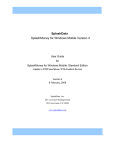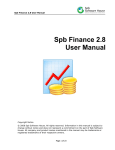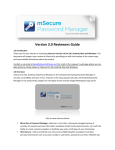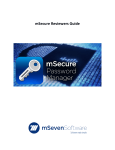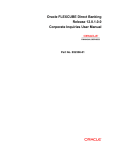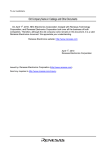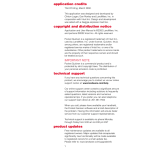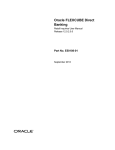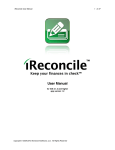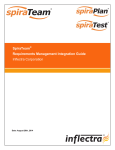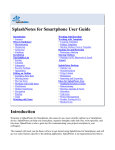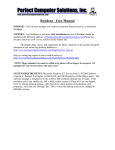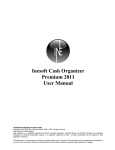Download User Manual
Transcript
SplashData SplashMoney for Windows Mobile Version 4 User Guide for SplashMoney Application for Windows Mobile (Applies to WM5 Pocket PC, WM6 Classic and Professional Devices) Version 4.00 8 February, 2008 SplashData, Inc. 201 Los Gatos-Saratoga Road #210 Los Gatos, CA 95030 www.splashdata.com Copyright information ©2000-2007 SplashData, Inc. All Rights Reserved. SplashData is privately held and based in Silicon Valley, California, USA. SplashData provides productivity software for Windows Mobile, Palm OS/Treo, Blackberry and Symbian. SplashMoney is one of the individual components of SplashWallet: a flagship product of SplashData. About this Guide SplashMoney application for Windows Mobile is a personal finance manager that facilitates online bank accounting and transactions. The application adds to the availability of platforms other than the Palm OS and Windows Desktop versions. The Windows Desktop version of SplashMoney replicates the functionality of the SplashMoney Application for Windows Mobile. This user guide provides the procedure and guidelines to carry various accounting and transaction activities such as, • Manage financial accounts and transactions. • Record savings, credit card and cash transactions. • Generate reports, budgets and charts. • Monitor and analyze the accounts and transactions. • Manage finances by connecting online and downloading transactions directly to SplashMoney. • Synchronize data between the powered handheld version and the desktop computer. • Transfer data to Quicken, Microsoft Money or a spreadsheet. Conventions The note icon and the text conventions in this manual: Convention Description Information ) Information icon Explains important features or information. Bold Typeface Identifies buttons, field names and dialog names. Italics Typeface Identifies the URL and variable elements. Acronyms and Abbreviations The acronyms and the abbreviations in this manual: Acronym Expansion QIF Quicken format OFX Open Financial Exchange CSV Comma Separated Values RAPI Remote API API Application Programming Interface Table of Contents 1 INTRODUCTION .................................................................................................................................................... 1 1.1 Overview of SplashMoney on Windows Mobile ................................................................................ 1 1.2 Requirements ....................................................................................................................................... 2 1.3 Installation ........................................................................................................................................... 3 1.3.1 Installing SplashMoney................................................................................................................ 3 1.3.2 Registering SplashMoney ............................................................................................................ 5 1.3.3 Security Options........................................................................................................................... 5 2 QUICK START GUIDE .......................................................................................................................................... 6 3 ACCOUNTS .............................................................................................................................................................. 7 3.1 Interface Settings for SplashMoney on Windows Mobile .................................................................. 7 3.1.1 Font Settings ................................................................................................................................ 7 3.1.2 Settings for Entering Characters .................................................................................................. 8 3.1.3 Accounts Register View Settings ................................................................................................. 8 3.1.4 Settings for Currency Display ...................................................................................................... 9 3.2 Accounting Features .......................................................................................................................... 10 3.2.1 Creating an Account................................................................................................................... 10 3.2.2 Setting the Online Mode ............................................................................................................ 11 3.2.3 Editing Accounts ........................................................................................................................ 12 3.2.4 Transferring Funds ..................................................................................................................... 12 3.3 Transaction Features.......................................................................................................................... 13 3.3.1 Adding a New Transaction ........................................................................................................ 13 3.3.1.1 Converting Currency ........................................................................................................... 14 3.3.1.2 Splitting a Transaction ........................................................................................................ 14 3.3.1.3 Creating/Editing a Transaction Type .................................................................................. 15 3.3.1.4 Editing the Payee, Category and Class Lists ....................................................................... 15 3.3.2 Editing a Transaction ................................................................................................................. 16 3.3.2.1 Purging a Transaction ......................................................................................................... 16 3.3.2.2 Deleting a transaction.......................................................................................................... 16 3.3.2.3 Splitting a Transaction ........................................................................................................ 16 3.3.2.4 Converting Currency ........................................................................................................... 16 3.3.3 Creating/Editing a Scheduled Transaction ................................................................................. 17 3.3.3.1 Setting the Upcoming Scheduled Transactions................................................................... 18 3.3.3.2 Recording the Upcoming Transactions ............................................................................... 19 3.3.4 Reconciling Operations .............................................................................................................. 20 3.3.4.1 Adjusting the Ending Balance............................................................................................. 21 3.3.5 Finding a Transaction ................................................................................................................ 21 3.3.6 Viewing the Transaction Details ................................................................................................ 21 3.4 Generating Reports ............................................................................................................................ 22 3.4.1 Defining Reports ........................................................................................................................ 22 3.4.2 Setting the Font and Row Color in the Reports View ................................................................ 23 3.4.3 Setting the Report Preferences ................................................................................................... 23 3.5 Planning Budgets............................................................................................................................... 24 3.5.1 Defining Budgets ....................................................................................................................... 24 3.5.2 Setting the Font and Row Color in the Budget View................................................................. 25 3.5.3 Setting the Budget Preferences .................................................................................................. 25 3.5.4 Entering the Budget Amount ..................................................................................................... 25 4 DESKTOP APPLICATION .................................................................................................................................. 26 4.1 Installation ......................................................................................................................................... 26 4.2 Desktop Interface .............................................................................................................................. 27 4.3 Menu Options .................................................................................................................................... 28 4.3.1 File ............................................................................................................................................. 28 4.3.2 Edit ............................................................................................................................................. 28 4.3.3 View ........................................................................................................................................... 29 4.3.4 Transaction ................................................................................................................................. 29 4.3.5 List ............................................................................................................................................. 29 4.3.6 User ............................................................................................................................................ 30 4.3.7 Sync............................................................................................................................................ 30 4.3.8 Help ............................................................................................................................................ 32 4.4 Settings for Synchronization ............................................................................................................. 33 4.4.1 Synchronizing Windows Mobile and Windows Desktop .......................................................... 33 4.5 Import/Export Options ...................................................................................................................... 35 4.5.1 Exporting Data from Windows Mobile to Windows Desktop ................................................... 35 4.5.2 Importing Data into Windows Mobile from Windows Desktop ................................................ 37 4.5.2.1 Importing and Viewing Data on Windows Mobile ............................................................. 37 4.5.2.2 Reviewing Imported Transactions on Windows Mobile .................................................... 38 4.5.3 Exporting Transactions to Quicken, Microsoft Money or a Spreadsheet .................................. 39 4.5.4 Importing Transactions from Quicken or Microsoft Money or a Spreadsheet .......................... 39 APPENDIX ................................................................................................................................................................ 40 GLOSSARY ............................................................................................................................................................... 42 TROUBLESHOOTING GUIDE .............................................................................................................................. 44 INDEX ........................................................................................................................................................................ 45 REVISION HISTORY .............................................................................................................................................. 46 0BIntroduction 1 Introduction The SplashMoney application on Windows Mobile 6.0 (and 5.0), is a personal finance manager and is a flagship product of SplashData. The application tracks accounts for expenditures and balances, and generates reports and budgets to analyze the banking activities. It is a standalone application and is totally independent and self contained. The SplashMoney application on Windows Mobile is not dependent on any other software application to run and functions independently. It is an excellent tool for online banking transactions and supports a desktop component with which the data is synchronized. The SplashMoney application on Windows Desktop synchronizes the various banking activities from the Windows Mobile version using the ActiveSync synchronization program. ) The Windows Desktop version of SplashMoney is supported only on – Windows 2000, Windows XP and Windows Vista. 1.1 Overview of SplashMoney on Windows Mobile SplashMoney is used on Windows Mobile 6.0 and 5.0 powered handhelds and also Windows Desktop. The desktop software included for Windows Mobile usage, enables easy viewing, editing and synchronization of the SplashMoney data with the handheld. This SplashMoney application adds to the availability of the software on platforms, other than the existing Palm OS and Windows Desktop. The usage is increased on more types of handheld devices. It is a versatile application that eases the management of financial transactions and accounts. The various functionalities and features available in the SplashMoney application aids in the following: • Manages finances including accounts and transactions, effectively. • Tracks the accounts balance. • Creates custom accounts and tracks individual account transactions. • Records savings and cash transactions. • Reconciles bank statements. • Records schedules for transactions and generates reminders. • Downloads accounts data from online banks. • Displays various editing functionalities accounting and transaction features. for Figure 1 SplashMoney on Windows Mobile 6.0 SplashMoney on Windows Mobile User Guide 1 0BIntroduction 1.2 Requirements SplashMoney application is an automated financial tool for personal account management. Pre-requisites The following are required, to install SplashMoney application on Windows mobile and also to facilitate online connection with banks. • Install Microsoft ActiveSync in the Windows Mobile and on the desktop. ActiveSync is required to synchronize the desktop application with the handheld. • Online banking using the handheld device is facilitated only by using a wireless enabled handheld device, running Windows Mobile. • A valid active data connection (over GPRS or WiFi) is required for online bank connection. If it is not available, then the SplashMoney application initiates a data connection by invoking the connection manager, existing in the Windows Mobile platform. • SplashMoney establishes online connection with banks that support OFX Direct Connect technology. • RAPI is an alternative to the standard ActiveSync interface. SplashMoney on Windows Mobile User Guide 2 0BIntroduction 1.3 Installation The SplashMoney application setup runs successfully on Windows 2000, Windows XP and Windows Vista. Download the SplashMoney application from the SplashData website (www.splashdata.com). 1.3.1 Installing SplashMoney To install the SplashMoney application on the desktop and Windows mobile, Step 1 Run the setup.exe file on the desktop. Click on Next and follow the setup wizard. Figure 2 SplashMoney Desktop WinMobile Wizard Step 2 The setup wizard then prompts a message to install the SplashMoney application on the Windows mobile, when connected. Figure 3 Pending Application Install prompt SplashMoney on Windows Mobile User Guide 3 0BIntroduction Step 3 Click on OK and follow the setup wizard. Click on Finish in the setup wizard, to complete the installation on the desktop. The Splash application on Windows Desktop is now installed. Step 4 Connect the Windows Mobile to the PC with a USB cable. The SplashMoney application automatically installs from the desktop to the Windows Mobile. The following message appears on the desktop. Click on OK to complete the installation on the Windows Mobile. Figure 4 Application Downloading Complete prompt Step 5 The SplashMoney application is installed on the Windows Mobile. Click on OK in the Start screen of the Windows Mobile. icon in the Programs Tap on the SplashMoney screen, to launch the application on Windows Mobile. Figure 5 Installing SplashMoney on Windows Mobile Step 6 The Synchronization Setup Wizard opens simultaneously on the desktop when installing the SplashMoney application on Windows Mobile. Follow the Synchronization Setup Wizard to establish the partnership between the SplashMoney application on Windows Desktop and Windows Mobile. The Microsoft ActiveSync screen shows the connection status. ) Follow the Synchronization Setup Wizard only after installing the SplashMoney application on the Windows Mobile. To synchronize the data between the handheld and desktop, refer to section 4.4 SplashMoney synchronization settings. SplashMoney on Windows Mobile User Guide 4 0BIntroduction 1.3.2 Registering SplashMoney To register for using SplashMoney application, 1. Launch the SplashMoney application on Windows Mobile. 2. The handheld then displays a screen with the registration details. 3. Enter the code provided by SplashData in the text box. 4. Tap on Register to register the application on Windows Mobile. 5. The handheld displays a message if an invalid code is entered in the text box. ) Once registered, it is not necessary to enter the code each time the application is launched. 6. To select the trial version click on Trial option in the registration screen. The trial version expires after 10 days and cannot be reused after the period of expiry. Figure 6 Registering SplashMoney 1.3.3 Security Options The data in the SplashMoney application on Windows Mobile is secured, by setting a password to open the application on the handheld. To set the password in the SplashMoney application, 1. Launch the SplashMoney application on Windows Mobile. The Account Summary view is displayed. 2. Tap on Menu and select Settings. From the displayed list of options, tap on Set Password. 3. Enter the password in the Set/Change Password dialog. Tap on OK. 4. Tap on the icon in Accounts Summary view or select Security Options from Settings. In the Lock on Exit or Poweroff: field, select the time that must elapse before SplashMoney application auto-locks. Tap on OK. Figure 7 Setting password SplashMoney on Windows Mobile User Guide 5 0BIntroduction The message to enter the password is displayed after launching SplashMoney. The message also appears on application restart, if the application was active while the handheld was previously shut down. 2 Quick Start Guide The SplashMoney user guide quick start section explains in brief the installation and starting of the SplashMoney application on Windows Mobile. To install SplashMoney on Windows Mobile 6.0 or 5.0, 1. Connect the Windows Mobile to the PC with a USB cable. 2. Run the setup.exe file and follow the wizard. 3. The Microsoft ActiveSync window opens on the PC and displays the connection status. 4. The application automatically installs on the pocket PC, when connected. 5. Launch the SplashMoney application on the handheld, from the Start menu. To use SplashMoney application on Windows Mobile, 1. From the Start menu, tap on SplashMoney to open the application. 2. The Accounts Summary view is the default screen that is first opened. 3. Tap on any of the available sample accounts to open the view window, with lists of transactions and accounts options. The data on the handheld is copied to the desktop by synchronizing the Windows Mobile with the desktop. The accounts and transaction options in the SplashMoney application on Windows Mobile are used to create and edit accounts, and to process transactions. The listed accounts options include edit, remove and create new accounts and transactions. Online banking, budgeting, reporting, reconciling and other operations are available on both the platforms (Windows Mobile and Windows Desktop). The application provides various displays and editing functionality for all accounts. Figure 8 Accounts Summary view ) It is possible to enter data in both the Windows Mobile and the Windows Desktop, and to synchronize the information between the two applications. SplashMoney on Windows Mobile User Guide 6 2BAccounts 3 Accounts The SplashMoney application on Windows Mobile, effectively manages the financial accounts and transactions. The accounts and transactions data stored in the handheld is synchronized with the Windows Desktop variant using the standard ActiveSync interface. The application also facilitates online banking transactions. 3.1 Interface Settings for SplashMoney on Windows Mobile The Account Summary view is the default startup window of the SplashMoney application when launched in Windows Mobile. About the accounts view interface setup: • The sample accounts and the created accounts types are listed in the Accounts Summary view with the individual net balance (Refer to Figure 8). • The net total of the account balance is displayed in the Accounts Summary view. View the amount cleared on date, by selecting the Cleared: option in the Total: drop down list. ) Transactions that are not cleared, displays the accounts with a debit tally, and displays the net amount in red with a negative (-) prefix added to the amount. 3.1.1 Font Settings To set the fonts in the Accounts Summary view for the list of accounts, 1. Tap on Menu in the accounts view and select the Settings option. 2. Tap on Font. Select the font type from the drop down list in the Font: field. Then, select the size of the fonts from the Size: list. 3. Select the required Font Style: options. 4. Tap on Done to complete the font settings. Font Style Output Bold Bold Italic Italic Underlined Underlined Strikethrough Strikethrough Figure 9 Setting Fonts SplashMoney on Windows Mobile User Guide 7 2BAccounts 3.1.2 Settings for Entering Characters Tap on the icon in the Accounts Summary view to enter alphanumeric characters using the keyboard functions. The other Microsoft input character options available are: 1. Block Recognizer - to enter alphanumeric characters mainly special characters. 2. Letter Recognizer - to enter alphanumeric characters mainly special characters. 3.1.3 Accounts Register View Settings 1. To open the accounts register view, tap and hold on any one of the accounts in the Accounts list of the Accounts Summary view. Tap on the drop-down list and select the transactions (All, Reconciled, Unreconciled, etc.) to be displayed in the register view. 2. To set the font in the register view, tap on Font in the Settings option of the Options menu. Enter the required details to customize the font appearance (Refer to Figure 9). 3. To set the accounts register view preferences, tap on the icon or tap on Preferences in the Settings option, to open the Preference View Dialog. Select the required display settings to view the fields in the accounts register view. The display setting options are: Register Preferences: Show Decimals and Show Years Show Fields: Cleared, Payee, Category, Memo, Account, Amount, Balance, Icon and Type. 4. To customize the colors of the row in the register view, tap on Row Color in the Settings option. 5. The Set Password and Security Options, follow the same procedure as in the Accounts Summary view (Refer to 1.3.3 Security options). Figure 10 Interface settings for accounts register view The accounts register view forms the main interface into an account and performs a host of operations with the help of the menu and the toolbar. SplashMoney on Windows Mobile User Guide 8 2BAccounts 3.1.4 Settings for Currency Display The SplashMoney application on Windows Mobile supports the feature to track accounts and transactions in various international currencies. The currency view, by default, displays a list of currencies along with the individual conversion rate (default value) with respect to the base currency. To add/edit a currency, 1. Tap on Menu in the Accounts Summary view and select the List option. 2. Tap on the Edit Currencies option. 3. In the displayed Edit Currencies screen, tap on Menu and select the New option. 4. In the displayed dialog enter the currency symbol in the Symbol: field and then, enter the conversion rate in the Conversion: field. 5. Tap on Done to enter the new currency along with the conversion rate, in the Edit Currencies screen. 6. Select the required currency as base and assign the conversion rate as 1.000000. 7. To assign the base currency, select the currency in the Edit Currencies dialog and tap on the Set as Base option from Menu. Tap on Yes to set the base currency. 8. Tap on the Edit option from Menu, to make changes to the existing currency. 9. To remove a currency type, select the currency from the list and tap on the Delete option from Menu. 10. Each time the base currency is changed, the total balance amount in the Accounts Summary view is automatically updated with respect to the newly selected base currency. HOW TO CALCULATE THE CONVERSION RATE? The conversion rate is relative to the base currency. For example: The base currency is a dollar ($) and the requirement is to enter the conversion rate for the Euro (E). If the rate of conversion is 0.67390 Euros to the Dollar, then the conversion rate is calculated by dividing 1 Dollar by 0.67390 Euros (1/0.67390). Then the resultant conversion rate is 1.48391. Figure 11 Currency settings ) Update the conversion rates periodically on par with the changing conversion rates. SplashMoney on Windows Mobile User Guide 9 2BAccounts 3.2 Accounting Features The SplashMoney application on Windows Mobile helps to create and edit accounts. The banking accounts belong to the following specific list: • Checking, Savings, Cash transaction, Credit and Line of credit accounts. • Asset, Liability and Money market accounts. 3.2.1 Creating an Account The Account summary view is the first interface displayed when the SplashMoney application is launched (Refer to Figure 8). To create a new account in Splash Money, 1. Tap the New option in the Accounts Summary view to open the Account Info dialog. 2. Tap on the icon, to use the keyboard functions of the application. 3. In the Name: field, enter the name of the new account. 4. Tap the Online: selector to enable (Refer to section 3.2.2 Setting online mode) or disable online banking facility. 5. In the Type: field, select the account from the list of available banking accounts. 6. In the Bank: field, enter the name of the bank if the Online: option is disabled. The name of the bank is filled automatically, when the Online: option is enabled. 7. In the Account #: field, enter account number if the Online: disabled. The account number automatically, when the Online: enabled. the bank option is is filled option is Figure 12 Creating an account 8. In the Beg.Bal.: field, enter the beginning balance. Enter the beginning balance for Credit and Liability accounts, as a negative amount. 9. Select the currency type used for this account in the Currency: field. 10. Customize the icon for the new account, using the Icons option in Options. Tap on Done to create a new account. 11. Select the Include in Account View Total check box to view the account name and the total account balance in the Accounts Summary view. ) To create or edit an account in the accounts register view: Tap and hold on any of the account in the Accounts Summary view, to open the accounts register view. Select the Account option and tap on Accounts Info dialog to edit the created account or add a new account. SplashMoney on Windows Mobile User Guide 10 2BAccounts 3.2.2 Setting the Online Mode To set up online mode, 1. Enter the Online Setup dialog by tapping on the -Enabled- option in the Online: field or tap the Online option from Options, in the Account Info dialog (Refer to Figure 12). ) SplashMoney application on Windows Mobile connects to a bank only with a wireless enabled device and a valid GPRS enabled account. 2. Select the Enable account access check box, for access to online accounts information. 3. Tap on the Bank: field or from Menu, tap the Select bank option. If the bank is supported online then the bank name appears in the Select Bank screen. Select the bank name from the displayed list. Tap on Done to enter the details in the Online Setup dialog. 4. Enter the online banking customer ID provided by the bank in the Customer ID: field. 5. Enter the online banking password provided by the bank, by tapping the Password: field or the Set Password option in the Menu. 6. Tap on the Account: field or the Select Account option from Menu. 7. In the displayed Select Account screen, select the account type. Tap on Done. 8. The account number is then entered in the Account: field, in the Online Setup dialog. 9. Tap on Done to complete the online setup. ) To download the transaction data from the bank (online): Tap on the icon, from the accounts register view or the Account Summary view, or tap on Go Online in the Accounts option from Menu, to download the transaction data from the bank. Then, select an online banking account to review the downloaded transactions. This download is confined only to the SplashMoney application and does not affect the bank account or raise an automatic request to the bank to correct any discrepancies. Figure 13 Setting online connection To change the online access password, 1. Tap on Options in the accounts register view and select the Settings option. 2. Then, tap on the Change Online Password option, to change the password for the accounts that have online access. ) The list of banks which support online service using direct connect is present on the OFX server. It is modified only by the OFX server administrator after prior permissions from the corresponding bank. SplashMoney on Windows Mobile User Guide 11 2BAccounts 3.2.3 Editing Accounts To edit the details of an existing account, 1. Tap on Menu in the Accounts Summary view and select the Accounts option from Menu. 2. For direct access, tap on the shortcut icon in the Accounts Summary view toolbar (or) tap on Edit Accounts from the list of accounting options, to open the Edit Accounts dialog to open the Edit Accounts. 3. To edit an account (only in SplashMoney), select the required account name from the list of existing accounts in SplashMoney, 4. From the Menu option, tap on Edit to open the Account Info view. 5. Edit the details and tap on Done to return to the Edit Accounts dialog (or) tap on the New option from Menu, to create a new account. 6. Tap on Done to complete the process or select another account name and repeat the procedure. Figure 14 Editing accounts 3.2.4 Transferring Funds To transfer funds from one account to another in SplashMoney, 1. Tap on the icon to directly open the Transfer Funds dialog in the Accounts Summary view (or) tap on Menu in the Accounts Summary view and select the Accounts option. Then, tap on Transfer from the list of accounts options, to open Transfer Funds dialog. 2. Enter the Date: of the transaction. Select the account name of the fund from where the account is withdrawn, in the From: field. 3. Enter the amount in the Amount: field, and in the To: field, select the account name for the funds to be transferred into. 4. Select the Cleared: box, if the transaction is cleared. Tap on OK to transfer the funds. Figure 15 Transferring funds ) Each account is displayed in brackets in the category list in the Edit Transaction dialog. SplashMoney on Windows Mobile User Guide 12 2BAccounts 3.3 Transaction Features The SplashMoney application on Windows Mobile helps to create and edit transactions. SplashMoney includes several in-built transaction types such as check, deposit, withdrawal, charge, payment, ATM and EFT. The various transaction functions in SplashMoney also allow to, create and edit custom transaction types. 3.3.1 Adding a New Transaction To add a new transaction, 1. Tap on Options in the accounts register view and select the Accounts option. 2. Tap on the icon to directly open the New Transaction dialog (or) tap on New Transaction in the list of accounts options, to open the New Transaction dialog. The name of the selected account is also displayed in the main title. 3. To enter the date of transaction in the Date: field, select the date from the calendar. 4. Select the name of the payee in the Payee: field from the drop down list or enter a new payee name. 5. Select the type of transaction (Check #, Withdrawal, Deposit, ATM, etc.) in the Type: field. For Check # type, enter the number in the box to the right. 6. Enter the transaction amount in the Amount: field. 7. Enter the category (Auto: Fuel, Auto: Insurance, Clothing, etc.) in the Category: field. 8. Enter the class (Business, Personal, etc.) in Class: field. Figure 16 Adding a new transaction 9. Scroll down and enter an additional note for the transaction in the Memo: field. 10. Select the as state as Uncleared, Cleared, Reconciled or Void in the State: field. Uncleared If the transaction is yet to be cleared by the bank. Cleared If the transaction is cleared in the bank. Reconciled If the transaction is verified. Void Disallow the transaction. 11. Tap on Done to create a new transaction. ) The amount in the Amount: field is recorded in a default home currency, known as the base currency. A foreign currency and its exchange rate, is entered in the Amount: field by using the Currency Converter option. SplashMoney on Windows Mobile User Guide 13 2BAccounts 3.3.1.1 Converting Currency To calculate the currency rate with respect to the base currency: First, set the currency. Then, 1. Tap on Menu in the New Transaction dialog (Refer to Figure 16). 2. Tap on the Convert Currency option to open the Convert Currency dialog. 3. From the drop down list of currency symbols in the From: field, select the required currency. Enter the amount to be converted in the box to the right. 4. The conversion rate of the currency selected in the From: field with respect to the currency of the account, is automatically displayed in the Conversion: field. 5. Tap on Menu and select Calculate to display the converted amount in the Amount: field. 6. Tap on Done. The amount is updated in the Amount: field, in the New Transaction dialog. ) Update the conversion rate periodically on par with changing conversion rates, in the Edit Currencies screen (Refer to Figure 11). This is used only for future transactions and no previous transactions reflect this new rate. Figure 17 Converting Currency 3.3.1.2 Splitting a Transaction To split a transaction amount, 1. In the New Transaction screen, tap on the Category: field. Then tap on the -SPLIT- option, to open the Split Transaction screen. 2. Tap on Menu in the Split Transaction screen. 3. Then, tap on the Edit option to enter the Category, Class, Memo and Amount details. 4. Tap on Done, to display the details in the Split Transaction screen. 5. If the Remainder displays a negative value, then tap on Adjust from Menu, to set the total amount. 6. Select Clear from Menu, to clear the categories. 7. Tap Done, to enter the total in the Amount: field, of the New Transaction dialog. Figure 18 Transaction splitting SplashMoney on Windows Mobile User Guide 14 2BAccounts 3.3.1.3 Creating/Editing a Transaction Type To create/edit a new transaction type, 1. In the accounts register view, select the List option from Menu and tap on the Edit Transaction Types option. 2. The Edit Transaction Type dialog displays a list of the Transaction and its Type. 3. To create a new transaction type, tap on Menu and select the New option. 4. In the displayed Transaction Type dialog, enter the name of the transaction type in the Type Name: field. 5. Then select the Type: as Deposit or Withdrawal, from the drop down list. 6. Tap on Done to enter the new transaction in the Edit Transaction Type dialog. 7. Tap on Done. The new transaction type is now available in the Type: list in the New Transaction dialog 8. To edit the transaction type, select the transaction type in the Edit Transaction Type dialog. Tap on Menu and select the Edit option to edit the existing type and tap on Delete to remove the selected transaction type. ) Built-in transaction types (Withdrawal, Deposit, ATM, etc.) cannot be edited or deleted. Figure 19 Creating/Editing a transaction type 3.3.1.4 Editing the Payee, Category and Class Lists To edit the payee, category and class options, Tap on Menu and select List in the Accounts Summary view (or) in the accounts register view, tap on Options and select List, to display the edit list. • To edit or create a new payee, tap on Edit Payees. Select the payee in the displayed Edit Payees screen. Then tap on Menu and select Edit. Tap on Done after modifying the details, in the Edit Payee dialog. In the next screen, tap on Done to enter the accounts register view or tap on New option from Menu to create a new payee name. • To edit or create a category (Salary, Groceries, Insurance, Household, Medical, etc.) tap on Edit Categories. Select the category and tap on Menu and select Edit. Tap on Done after modifying the details in the Edit Categories dialog. Enter a sub-category if required. Use the Icon option to select an icon from the available list. In the next screen, tap on Done to enter the accounts register view or tap on the New option from Menu to create a new category. • To edit or create a class (Business, Personal, etc.) tap on Edit Classes. Select an existing class and tap on Menu and select the Edit option. Modify the details and tap on Done to enter the accounts register view or tap on New option from Menu, to create a new class. SplashMoney on Windows Mobile User Guide 15 2BAccounts 3.3.2 Editing a Transaction The Edit Transaction dialog is similar to the New Transaction dialog (Refer to Figure 16). To edit an existing transaction, 1. Open the accounts register view by tapping and holding on an account name in the Accounts Summary view. In the displayed accounts register view select a payee. Then, tap on the Options menu and select Account option. 2. From the list of account options, tap on Edit Transaction to open the Edit Transaction: dialog. The account name is also displayed in the title. 3. Edit the details in the available fields (date, type, payee, category, class, amount, memo and state). The field functions are similar to the fields in the New Transaction dialog. 4. Tap on Done, to save the edited details in the accounts register view. ) Tap on the category in brackets to transfer funds directly from this transaction screen. 3.3.2.1 Purging a Transaction The Purge Transaction option in the Edit Transaction: dialog, removes a transaction from the accounts register view and adjusts the beginning balance in accordance with the amount of the purged transaction. To purge a transaction, 1. Tap on Menu in the Edit Transaction dialog. Select the Purge Transaction option. 2. A pop-up message to confirm the purge action, appears. Tap on OK to purge the transaction. 3. The transaction is removed and does not appear in the accounts register view. 4. The beginning balance is adjusted in accordance with the purged transaction. 3.3.2.2 Deleting a transaction The Delete Transaction option, totally deletes a transaction. There are no changes made to the beginning balance, as made for a purged transaction. ) The deleting and purging transactions are confined to SplashMoney application only and not in any bank. Figure 20 Purging a transaction 3.3.2.3 Splitting a Transaction The -SPLIT- function is similar to the split option in the New Transaction: dialog (Refer to 3.3.1.2 Splitting a Transaction). 3.3.2.4 Converting Currency The Convert Currency function is similar to the currency conversion option in the New Transaction: dialog (Refer to 3.3.1.1 Converting currency). SplashMoney on Windows Mobile User Guide 16 2BAccounts 3.3.3 Creating/Editing a Scheduled Transaction The SplashMoney application sets up regularly occurring transactions, by scheduling them. A scheduled transaction allows to, • Record transactions manually. • Generate a reminder to record an upcoming transaction. To create/edit a scheduled transaction, 1. Tap on Options in the accounts register view and select List. 2. Tap on the Edit Scheduled Transactions option, to open the Scheduled Transaction screen. 3. Tap on the New option from Menu, to create a scheduled transaction. 4. Select the account name from the drop-down list. 5. In the displayed New Scheduled… dialog, enter the details in the given fields (Date, Payee, Type, Amount, Category, Class and Memo). 6. Tap on Done to create a scheduled transaction. 7. To edit a scheduled transaction, select a payee from the existing list. Then, tap on Edit option from Menu, to open the Edit Scheduled… dialog. 8. Edit and tap on Done, to enter the details in the scheduled transactions list. Figure 21 Creating/editing a scheduled transaction ) The Date: field when tapped, displays the Periodicity dialog which is used to set the repeat frequency of the scheduled transactions. SplashMoney on Windows Mobile User Guide 17 2BAccounts 3.3.3.1 Setting the Upcoming Scheduled Transactions To set the upcoming scheduled transactions, 1. Open the Scheduled Transaction dialog and tap on the Date: field, in the New Transaction dialog, to open the Periodicity dialog. ) The Periodicity dialog is also opened by tapping on the Date: field in the Edit Scheduled… dialog invoked from the Edit menu option, in the Scheduled Transaction screen. 2. In the Next Date: field, enter the date of the next (or first) occurrence of the scheduled transaction. Select the down arrow to open the calendar. 3. In the Frequency: field, select the frequency (weekly, monthly, quarterly, annually, etc.) of the transaction, from the given list. 4. In the Repeat: field, select from the drop down list: • Indefinitely, for ongoing transactions (For example, cable TV, newspaper bills, etc.). • # of times, for specifying transactions that occur for a specified number of times. Enter the number in the box. • Figure 22 Setting upcoming transactions in the Periodicity dialog 5. In the Enter: field, select from the list, • Manually - to record the transaction manually. On start up of the SplashMoney application on Windows Mobile, a pop up reminder of the upcoming scheduled transactions appears. Tap on Yes to view the list of scheduled transactions. • Remind me - a reminder to manually record a transaction periodically, even when the application is not running. Enter the number of days before the due date of the transaction (reminder period), in the number box. Tap on Done to return to the New Scheduled… dialog. 6. After entering other details in the New Scheduled… dialog, tap on Done to view the details in the list in the Scheduled Transaction screen. 7. Tap on Done in the Scheduled Transaction dialog to return to the accounts register view. 8. Open the Scheduled Transaction screen from the Edit Scheduled Transactions option in the accounts register view, to view the list of scheduled transactions. SplashMoney on Windows Mobile User Guide 18 2BAccounts 3.3.3.2 Recording the Upcoming Transactions To record an upcoming transaction, 1. Tap on the icon to open the Upcoming Transactions screen (or) tap on Menu in the Accounts Summary view (or the accounts register view) and select the Accounts option and then tap on the Upcoming Transactions option, to open the Upcoming Transactions screen. 2. The details of the upcoming scheduled transactions (Date, Transaction and Amount) appear in the Upcoming Transactions screen. 3. Select the time period (1 week, 1 month, 1 year, etc.) from the list in the Through field, to filter the scheduled transactions. 4. Tap on Record All option from Menu, to record all transactions currently in view. 5. Select a particular transaction and tap on Record to record only the selected transaction. ) The recorded transactions are moved to the accounts register view from the Upcoming Transactions screen. 6. To edit a transaction before recording, tap on the Edit option from Menu, to open the Edit Transaction dialog. After editing, tap on Record. The transaction is recorded and is not visible in the Upcoming Transactions screen. ) Only the first transaction in the series can be edited. It is not possible to edit a transaction that is out of order. If a future occurrence of the scheduled transaction is to be edited, then first record the previous occurrences of the scheduled transaction. 7. To delete a specific occurrence of the scheduled transaction, the Skip option from Menu, is used. The future transaction still occurs. 8. Tap on Done to close the dialog. Figure 23 Recording upcoming transactions On start up of the SplashMoney application on Windows Mobile, 1. A pop up reminder of the upcoming scheduled transactions appears, as entered in the scheduled transaction settings. 2. Tap on Yes in the message box to view the scheduled transactions and then manually record the transactions. 3. The updated accounts are shown in the Accounts Summary view or the accounts register view. ) To edit or delete all occurrences of the scheduled transaction, use the Scheduled Transaction screen. SplashMoney on Windows Mobile User Guide 19 2BAccounts 3.3.4 Reconciling Operations Reconciliation operation is the process of comparing the accounts balance and matching it with the various transactions, to detect any differences between the amount in the account register and its printed bank statement. To set up the reconcile operations, 1. Tap on the icon to open the Reconcile Setup dialog (or) tap on Options in the accounts register view and select the Account option. From the list of accounts options, tap on the Reconcile option. The Reconcile Setup dialog then appears. 2. Enter the beginning balance (by referring to the bank statement) in the Beginning Bal : field. 3. Enter the ending balance (by referring to the bank statement) in the Ending Bal: field. 4. Enter the date from the calendar in the Closing Date: field. The closing date is used to set the last date of the expected reconcile operation. 5. Tap on Continue to open the Reconcile dialog. All transactions before the closing date are listed in the Reconcile screen (Date, Type, Payee, Amount, etc.). 6. Check the items that match the printed bank statement. Use the menu options, All – to select all the items in the list. None – to disable all the selected items. Cancel – to cancel the reconcile operation and return to the accounts register view. Figure 24 Reconciling Operations 7. The difference in the amount is displayed in Difference: field, in the Reconcile screen. 8. The Difference: field should display 0, when all items in the list are checked. This signals the completion of the reconcile operation. Tap on Done to complete the reconcile operation. 9. If the Difference: field shows a balance, then this signals that the items in the list are not reconciled. Then, if the Done option is tapped, a pop-up message mentioning the discrepancy in the balance, appears. 10. To resolve this discrepancy and to create an adjustment, tap on Yes in the message pop-up. Then the amount appears in the accounts register view as Reconcile Adjust. ) In an incomplete reconcile operation, the previous state of the Reconcile screen is preserved. This helps to continue the reconcile operation, when returned. SplashMoney on Windows Mobile User Guide 20 2BAccounts 3.3.4.1 Adjusting the Ending Balance An alternative for the reconcile operation is the Adjusting Ending Balance option. To adjust the ending balance, 1. Tap on Options in the accounts register view and select the Account option. Then, tap on the Adjusting Ending Balance option, to open the Adjusting Ending Balance dialog. 2. The Balance option displays the total of all the cleared and uncleared transactions in the accounts register view. 3. Tap the down arrow to display the Cleared option. This option displays the total of all the cleared and reconciled transactions in the accounts register view. The printed statement of the bank matches with this total balance. 4. Enter the new balance in the Enter New Balance: field. The amount entered in this field is adjusted with the beginning balance, for that particular selected account. 5. Tap on OK to adjust the ending balance in the accounts register view. ) Adjusting the ending balance function is confined only to the SplashMoney application. Changes made to the ending balance does not affect the bank account balance or raise an automatic request to the bank to correct any discrepancies in the ending balance. Figure 25 Adjusting the ending balance 3.3.5 Finding a Transaction 1. To search for an existing transaction record, tap on Options in the accounts register view and select the Account option. Then, tap on Find Transactions. In the Find dialog, enter the search item and tap on Done. 2. The name of the payee appears along with the amount in the Find Results dialog. 3. To filter the searched list, select from the list (All, Reconciled, Unreconciled, Cleared, Uncleared, Downloaded and Imported) of options. ) The search item can either be a payee name or the amount 3.3.6 Viewing the Transaction Details 1. To view the details of a particular transaction, select the transaction in the accounts register view. 2. Tap on the Details option in the left hand corner of the screen, to display the transaction details (like the Date, Type, Payee, Memo, Account name, etc.) for the selected transaction. SplashMoney on Windows Mobile User Guide 21 2BAccounts 3.4 Generating Reports The account transactions are viewed as charts for easy reference, by generating reports for the transactions. To generate and view reports of the accounting and transaction details in SplashMoney on Windows Mobile, Tap on the icon to open the Reports screen: Alternative method to open the Reports screen, • Tap on Menu in the Accounts Summary view or tap on Options in the accounts register view, and select the Account option. • Tap on the Reports option. The Reports screen, by default, displays the payee and amount columns. 3.4.1 Defining Reports 1. Tap on Options in the Reports screen and tap on the Define option. 2. In the displayed Define Report dialog, select the account name from the drop down list, in the Account: field. 3. To generate the report (as payee, category or class), select the required option from the By: drop down list. 4. Select the duration for which the reports are to be generated, in the Period: field. 5. If Custom from the Period: field, is selected, then, select the Start Date: and the End Date: by tapping on the down arrow in each field. 6. To display the transactions that show nil amounts, enable the Show Empty Items. Tap on Done to enter the details in the Reports screen. 7. To view the details of the report, tap and hold on any item in the list displayed in the Reports screen. This opens the Reports Details: screen. Tap on Done to return to the Reports screen. Figure 26 Defining reports SplashMoney on Windows Mobile User Guide 22 2BAccounts 3.4.2 Setting the Font and Row Color in the Reports View To alter the appearance of the fonts in the reports view, tap on the Font option from Options. In the Font dialog, modify the details (font type, font size and font style) and tap on Done, to set the font for the Reports screen. To set the row color for the Reports screen, tap on the Row Color option from Options and select the color in the displayed Color dialog. Tap on OK to set the row color. 3.4.3 Setting the Report Preferences To set the report details for the pie chart, 1. Tap on Options in the Reports screen. Then, tap on the Preferences option, to open the Report Preferences dialog. 2. Set the preferences in the Report Preferences dialog. • To view the name of the payee, select the Name check box. • To view the amount, select the Amount check box. • To view the percentage, select the Percent check box. 3. Tap on Done to return to the Reports screen. 4. To view the pie chart, tap on Options and then tap on the Charts option. ) Tap on the individual sections in the pie chart to view the details in the Reports Details: screen. Figure 27 Generating reports – a pie chart • To view only the transactions with a positive balance, tap on the Incomes option from Options, in the pie chart screen. • To view only the transactions with a negative balance, tap on the Expenses option from Options, in the pie chart screen. 5. Tap on the Define option from Options in the pie chart screen, to edit the report definition. Tap on the Preferences option from Options in the pie chart screen, to edit the report preferences. 6. To return to the Reports screen from the pie chart screen, tap on the List View option from Options in the pie chart screen. 7. Tap on Done, to return to the Accounts Summary view or the accounts register view, depending on the view from where the Reports screen was initially invoked. ) After returning to the accounts view, the next time when the Reports screen is invoked, the previous exit state of the Reports screen appears. SplashMoney on Windows Mobile User Guide 23 2BAccounts 3.5 Planning Budgets The SplashMoney application on Windows mobile allows to plan and view budgets. Tap on the icon to open the Budgets screen, Alternative method to open the Budgets screen, • Tap on Options in the Accounts Summary view or from the accounts register view and select the Account option. • Tap on the Budgets option. The Budgets screen displays by default the payee column. 3.5.1 Defining Budgets To define the budget, 1. Tap on Options and select the Define option. In the displayed Define Budget dialog, select the required budget display (as payee, category or class) in the By: field. 2. Specify the time period to define the budget period in the From: field, from the list (Last Month, Last Year, This Month, etc.). 3. To display the transactions that show nil amounts, enable the Show Empty Items. 4. Tap on Done to enter the details in the Budgets screen. Figure 28 Defining Budgets SplashMoney on Windows Mobile User Guide 24 2BAccounts 3.5.2 Setting the Font and Row Color in the Budget View To alter the appearance of the fonts in the Budgets screen, tap on the Font option from Options. In the Font dialog, modify the details (font type, font size and font style) and tap on Done, to set the font for the Budgets dialog. To set the row color for the Budgets screen, tap on the Row Color option from Options and select the color in the Color dialog. Tap on OK to set the row color. 3.5.3 Setting the Budget Preferences To set the budget details that is displayed in the budget view, 1. Tap on Options in the Budgets dialog. Tap on the Preference option to open the Budget Preferences dialog. 2. Set the details in the Show Columns: option. • To view the budget amount, enable the Budget check box. • To view the actual amount of the transaction, enable the Actual check box. • To view the difference in the actual amount and the budget, enable the Difference check box. 3. Tap on Done to view the columns in the Budgets screen. ) To view the details of the budget, tap on any item in the Actual or Difference column, in the Budgets screen. This opens the Budget Details: dialog. Tap on Done to return to the Budgets screen. Figure 29 Budget view 3.5.4 Entering the Budget Amount To specify the budget for each item (payee, category or class), 1. Tap on the any of the item in the Budget or Payee column, to open the Budget Amount dialog. Tap on any one of the available Deposit or Withdrawal option, to select it. 2. Enter the amount in the Budget Amount box. Tap on Done to view the details in the Budgets screen. The difference in the budget amount and the actual transaction amount is displayed in the Difference column. 3. Tap on Done to return to the Accounts Summary view or the accounts register view. ) After returning to the accounts register view, the next time when the Budgets screen is invoked, the budget screen that was previously displayed while exiting, appears. SplashMoney on Windows Mobile User Guide 25 3BDesktop Application 4 Desktop Application The SplashMoney on Windows Desktop application features are similar to the SplashMoney application on Windows Mobile. 4.1 Installation To install the SplashMoney application on Windows Desktop, 1. Download and run the setup.exe file. (Refer to section 1.3.1 Installing SplashMoney) 2. The SplashMoney Desktop WinMobile wizard appears. Follow the steps in the wizard to complete the installation on the desktop. 3. The shortcut for the SplashMoney application is displayed on the Windows Desktop. 4. Click on the shortcut to open the SplashMoney application. ) Enter the registration code or click on Trial in the registration screen. The trial version expires after 10 days and cannot be reused after the period of expiry. SplashMoney on Windows Mobile User Guide 26 Desktop Application 4.2 Desktop Interface Delete Transaction Transfer Funds Edit Transaction Download Transaction New Transaction Figure 30 SplashMoney Application on Windows Desktop SplashMoney on Windows Mobile User Guide 27 Desktop Application 4.3 Menu Options The options available in the SplashMoney application of Windows Desktop: 4.3.1 File Menu Options Description New Account… Creates a new account. Delete Account… Deletes selected account. Account Info… Edits selected account. Go Online… Downloads transaction data from online bank. Adjust Ending Balance… Opens the Adjust Ending Balance dialog. Purge Transactions… Opens the Purge Transactions dialog. Upcoming Transactions… Opens the Upcoming Transactions dialog. Set Password… Sets password to protect the data in SplashMoney Windows Desktop version. Import Imports QIF, OFX or CSV data from other applications. Export Exports date in QIF or CSV file formats. Print… Prints the displayed data. Print Preview Opens the preview of the document before sending to the printer. Print Setup… Edits the printer settings. Exit Quits the SplashMoney application on Windows Desktop. 4.3.2 Edit Menu Options Description Cut Cuts the selected data. Copy Copies the selected data. Pastes Pastes the cut or copied data. SplashMoney on Windows Mobile User Guide 28 Desktop Application Select All Selects all the data. 4.3.3 View Menu Options Description Show Columns… Opens the Show Columns dialog, to select the state, icon, date, transaction type and other fields to be displayed in the window. Row Color… Opens the Color dialog, to change the row color. Set Font… Opens the Font dialog, to change the font properties. Preferences… Opens the Preferences dialog, to show or hide decimals and to set date and number format. Status Bar Shows or hides the Status Bar. 4.3.4 Transaction Menu Options Description New… Opens the Transaction Info dialog, for creating a new transaction. Edit… Opens the Transaction Info dialog, for editing a selected transaction. Delete… Deletes a selected transaction. Transfer… Opens the Transfer Funds dialog to transfer the funds between two accounts. 4.3.5 List Menu Options Description Edit Payees… Opens the Edit Payees dialog, to edit the name of the payee or create a new payee name. Edit Categories… Opens the Edit Categories dialog, to edit the category or create a new category. SplashMoney on Windows Mobile User Guide 29 Desktop Application Edit Classes… Opens the Edit Classes dialog, to edit the class or create a new class. Edit Currencies… Opens the Edit Currencies dialog, to edit the currency or create a new currency. Edit Transaction Types… Opens the Edit Transaction Typed dialog, to edit the transaction type or create a new transaction type. Edit Scheduled Transactions… Opens the Edit Scheduled Transactions dialog, to edit the scheduled transaction or create a new scheduled transaction. 4.3.6 User Lists the Windows Mobile user names which synchronize with the Windows Desktop. Select the required user name to ensure proper synchronization with that particular Window Mobile user. 4.3.7 Sync When SplashMoney is installed, there is a Standalone user automatically created. In order to Sync SplashMoney on Desktop to SplashMoney on the device, a user needs to be created (with the device ID as the username) SplashMoney on Windows Mobile User Guide 30 Desktop Application Click on Start Sync menu item (ensure that your device is connected to the Desktop) You will see SplashMoney identifies the device User ID, along with the Platform and Status Note: At this stage if you do not see Status as Supported, it means that the device is not connect (Check Windows Mobile Active Sync / Windows Mobile Device Center status) Hit Sync, you will see the Status as Completed SplashMoney on Windows Mobile User Guide 31 Desktop Application You will also notice that the new user is created (Device ID) and automatically selected. From here on, all you will need to do is set the same password (if any) on device and desktop and hit the Sync button If you would like to change the Sync Setting, hit Sync setting and choose appropriate option. 4.3.8 Help Menu Options Description About SplashMoney Desktop… Opens the About SplashMoney Desktop… screen, which displays the information about the application. User Guide… Opens the SplashMoney User Guide. pdf file. SplashMoney on Windows Mobile User Guide 32 Desktop Application 4.4 Settings for Synchronization (Read 4.3.7 to create new Device user) The transactions created in SplashMoney can be, • Automatically uploaded to Quicken 99 or later for Windows. • Exported in QIF format for importing into Microsoft Money, Quicken 98 or earlier for Windows or Quicken for Macintosh (or) exported in CSV format for viewing with a spreadsheet, database or word processor. • Exported in QIF format and then imported into SplashMoney from Quicken, Microsoft Money or an online bank. ) You must open the Windows Mobile at least once for Synchronization to happen. 4.4.1 Synchronizing Windows Mobile and Windows Desktop To synchronize the data in the SplashMoney application on Windows Desktop and the Windows mobile, 1. Connect the Windows Mobile to the PC with the USB Cable. 2. Ensure that the Microsoft ActiveSync screen displays as Connected. Figure 31 Microsoft ActiveSync screen 3. Open the SplashMoney application on Windows Desktop. 4. From the Sync menu on the SplashMoney desktop window (Refer to Figure 30), click on the Start Sync option. 5. The SplashMoney Synchronization screen is displayed. 6. Click on the Sync Settings option. The SplashMoney ActiveSync Settings dialog is then displayed. Figure 32 SplashMoney Synchronization screen SplashMoney on Windows Mobile User Guide 33 Desktop Application Figure 33 Synchronization settings Synchronize the files Synchronizes the changes made on the handheld and desktop. Desktop overwrites handheld Copies all data from the Windows Desktop to the handheld. All the data in the handheld are replaced. Handheld overwrites desktop Copies all data from the Windows Mobile to the desktop. All the data in the desktop are replaced. Do nothing Does not synchronize between the handheld and the desktop. 7. Click on OK to enable the selected synchronization settings. 8. Then, click on Sync option in the SplashMoney Synchronization screen to synchronize the data between the SplashMoney application on the Windows Desktop and Windows Mobile. 9. Click on Check For User option to view the connection status in the SplashMoney Synchronization screen. ) If the Sync Settings and Sync options are disabled, then click on the Check For User option. This detects the connection status, and if connected, the options are enabled. SplashMoney on Windows Mobile User Guide 34 Desktop Application 4.5 Import/Export Options The Import/Export option on Windows Desktop facilitates the following: • Importing the QIF, OFX and CSV file formats into the Windows Desktop. • Exporting to the QIF or CSV file formats in order to transfer the data to other applications. Description of the file formats: File Format Description QIF It is the old Quicken format. Quicken 2005 exports to this format but does not import it. OFX Open Financial Exchange is the standard, recently adopted by Quicken, Microsoft Money, and many US online banks. OFX is also known as QFX (Quicken). CSV Comma Separated Values is a widely supported text format that is opened in spreadsheets such as Excel, and text editors such as Notepad and Text Edit. 4.5.1 Exporting Data from Windows Mobile to Windows Desktop Figure 34 3rd-party apps via Import/Export settings SplashMoney on Windows Mobile User Guide 35 Desktop Application To export data from Windows Mobile to the desktop, 1. Connect the handheld to the PC. 2. In the displayed Microsoft ActiveSync screen on the desktop, click on the SplashMoney icon to open SplashMoney ActiveSync Settings (Refer to Figure 33). 3. Select the 3rd Party apps via Import/Export option from the Synchronize with: field. 4. Then, select the Export from WinMobile to Desktop check box. 5. Select the, • Export transactions to QIF option, to export the transactions to the QIF (for Quicken or Microsoft Money) format. (or) • Export transactions to CSV(Spreadsheet, etc.) option, to export the transactions to the CSV format. 6. Click on OK to export the transactions in the required format, to the desktop. The default location like C:\Documents and Settings\dchristy\My Documents\SMExport\...,can be changed using the Browse… button. 7. Click on the Format…button to set the date and number formats the same as the desktop settings. 8. Then, click on the Sync option in the SplashMoney Synchronization screen to synchronize the data. 9. Open the SplashMoney application on the Windows Desktop (Refer to Figure 30). 10. From the File menu, select the Import option. 11. Click on the required file format (QIF or CSV) from the list. From the displayed Import File screen, select the required file to be imported, and click on Open. 12. A Select Account dialog is displayed. Create a new account or select an existing account, to import the data. 13. Click on OK to import the selected file format (QIF or CSV) to the Windows Desktop. Figure 35 Selecting the account for importing transactions To export only the new transactions from the Windows Mobile to the desktop, 1. Select the Export new transactions only option. 2. Follow the procedure mentioned above to export data. SplashMoney on Windows Mobile User Guide 36 Desktop Application 4.5.2 Importing Data into Windows Mobile from Windows Desktop To import the data to the Windows Mobile from the Windows Desktop application, 1. Open the SplashMoney application on Windows Desktop. 2. From the File menu, select the Export option and click on the required file format QIF or CSV) from the list. 3. From the displayed Export File screen, save the file to be exported to the desktop of the computer. 4. The Export Transactions dialog is displayed. Select the required transactions settings and click on OK. 5. Now, connect the Windows Mobile to the PC. Figure 36 Export Transactions dialog 6. In the displayed Microsoft ActiveSync screen on the desktop, click on the SplashMoney icon to open the SplashMoney ActiveSync Settings, select the 3rd Party apps via Import/Export option from the Synchronize with: field (Refer to Figure 34). 7. Select the Import files to WinMobile from Desktop option. 8. Click on the Format…button to set the date and number formats the same as the desktop settings. 9. Click on OK to import the transactions in the required format, to the Windows Mobile. The default location like C:\Documents and Settings\dchristy\My Documents\SMExport\...,can be changed using the Browse… button. 10. Click on Sync option in the SplashMoney Synchronization screen, to synchronize the data. 4.5.2.1 Importing and Viewing Data on Windows Mobile When the SplashMoney application is opened on Windows Mobile, a message to import is displayed. To import and view the data on Windows Mobile, 1. Tap on Yes in the message box. The Import Accounts dialog is displayed. Figure 37 Importing pending data 2. Select the transaction to be imported, in the Import Transactions from: field. 3. Select the account name to which the transaction is to be imported, in the Import Transactions into: field. SplashMoney on Windows Mobile User Guide 37 Desktop Application 4. Tap on Now to import. ) To import the transactions into a new account, enter the account name in the Enter Name For <New Account>: field. 5. To import the transactions the next time the SplashMoney application is opened on the Windows Mobile, tap on the Later option from Menu, in the Import Accounts dialog. 6. Repeat the procedure to import other pending transactions. Figure 38 Import Accounts dialog 4.5.2.2 Reviewing Imported Transactions on Windows Mobile 1. When the account name in the Accounts Summary view is tapped, a message to accept the review of the imported transactions is displayed. 2. Tap on Yes to display the Review Transaction dialog. • Tap on the Accept All option, to accept all transactions. • Tap on Change Match option and select the transaction in the displayed Match Transaction screen. Tap on Match. This transaction is then entered in the Your Entry: field in the Review Transaction dialog. • Tap on the Edit option from Menu to enter the Edit Review Transaction dialog. Edit the transaction details to be displayed in the Bank Entry: field, in the Review Transaction dialog. • Use the Next option and the Prev option to navigate between the next and previous transactions. 3. Tap on Accept to accept the transaction and return to the accounts register view. Figure 39 Review Transaction dialog SplashMoney on Windows Mobile User Guide 38 Desktop Application 4.5.3 Exporting Transactions to Quicken, Microsoft Money or a Spreadsheet The desktop version of SplashMoney allows, to record transaction when travelling and later upload the transactions to, • Quicken through the QIF or OFX file format. • Microsoft Money through the QIF or OFX file format. • Spreadsheet, database or a word processor through the CSV format. SplashMoney does not synchronize with Quicken or Microsoft Money or a spreadsheet but facilitates uploading of transactions automatically, so that the transactions created on the handheld need not be re-entered on the desktop. 1. For the synchronization to be successful, exit Quicken or Microsoft Money before performing the synchronization. ) The accounts in SplashMoney must have the same names as the accounts in Quicken or Microsoft Money. 2. Export the files (QIF, OFX or CSV) to the desktop from Windows Mobile using the 3rd Party apps via Import/Export option in the SplashMoney ActiveSync Settings screen (Refer to section 4.5.1 Exporting data from Windows Mobile to Windows Desktop). 3. Then, import the files into Quicken, Microsoft Money or a spreadsheet. ) After importing the file formats into Quicken, Microsoft Money or spreadsheet, delete the files on the desktop. If the files are not deleted, then the next time when the files are imported to Quicken, Microsoft Money or a spreadsheet, it creates duplicate transactions. 4.5.4 Importing Transactions from Quicken or Microsoft Money or a Spreadsheet 1. Exit Quicken or Microsoft Money before synchronization. 2. Then, export the files (QIF, OFX or CSV) from Quicken or Microsoft Money or a spreadsheet, to the desktop. 3. Import the files to Windows Mobile using the 3rd Party apps via Import/Export option in the SplashMoney ActiveSync Settings screen. (Refer to section 4.5.2 Importing data into Windows Mobile from Windows Desktop). SplashMoney on Windows Mobile User Guide 39 Appendix ACCOUNTS SUMMARY VIEW SHORTCUT ICONS TOOLBAR Icon Description Opens the Edit accounts dialog. Opens the Transfer Funds dialog. Opens the Reports screen. Opens the Budgets screen. Opens the Upcoming Transactions screen. Opens the Security Options dialog. Connects online to download data from the bank. SplashMoney on Windows Mobile User Guide 40 ACCOUNTS REGISTER VIEW SHORTCUT ICONS TOOLBAR Icon Description Returns to the Accounts Summary view Opens the New Transaction dialog. Opens the Reports screen. Opens the Budgets screen. Opens the Upcoming Transactions screen. Opens the Reconcile Setup dialog. Opens the Preference View dialog. Connects online with the bank. SplashMoney on Windows Mobile User Guide 41 Glossary Accounts register view All the transactions for an account are listed in the accounts register view. Tap and hold on the account name to open the list of transactions. Beginning balance The current balance in the bank is manually entered as the beginning amount in SplashMoney, when creating an account. Budgets The list of all planned expenses and revenues based on the Payee, Category or Class. Built-in transaction The transactions that are built with the software. These transactions cannot be edited or deleted. CSV The common file format that is read by a spreadsheet, database or word processor. It stands for Comma Separated Values. Currency conversion rate Rate at which one currency is converted into another. It is also called the rate of exchange or foreign exchange. This rate is secured through major international banks. Custom transaction The transactions that are created in SplashMoney and which are not built-in. These transactions can be edited and deleted. Ending balance The balance of all transactions entered in an account register including postdated transactions. Memo SplashMoney on Windows Mobile User Guide The additional information for a transaction that is short, focuses on a single topic, reports information, makes a request, or recommends action. 42 Microsoft Money The personal finance software of Microsoft for computers using the Microsoft Windows operating system Purging The transactions that are removed from the accounts register view. The purged amount is adjusted with the beginning balance. Quicken The personal financial software that manages finances and investments. It provides financial and business management solutions for the business and personal finance markets, globally. It tracks investments and manages finances, online. Reconcile Operations Reconciliation operation is the process of comparing the accounts balance and matching it with the various transactions, to detect any differences between the amount in the account register and its printed bank statement. Reconcile adjust The transaction added to the accounts register after the reconciling operation. Reports The consolidated income and expense over a specified period of time based on Payee, Category or Class. SplashMoney on Windows Mobile User Guide 43 Troubleshooting Guide If the SplashMoney application on Windows Mobile and Windows Desktop are not synchronizing • Check the synchronization settings of the application. Open the SplashMoney application on Windows Desktop and click on the Sync menu. Then, click on the Start Sync option. The SplashMoney Synchronization screen is displayed. If the status is showing as Not Connected, then check for the connection status between the handheld and the desktop. The Windows Mobile has to be connected to the desktop for the synchronization to happen. • When the Status is showing as connected then the Sync Settings option and the Sync option are enabled. Click on the Sync Settings option. The SplashMoney ActiveSync Settings dialog is displayed. If the Do nothing option is selected, then synchronization will not happen between the desktop and the handheld. SplashMoney on Windows Mobile User Guide 44 INDEX accounting, 7, 10 accounts register, 8 accounts summary, 6 adjusting balance, 21 adjusting ending balance, 21 base currency, 9 beginning balance, 10 budget amount, 25 budget preferences, 25 budget view, 25 budgets, 24 category, 15 characters, 8 class, 15 convert currency, 14 create account, 10 create scheduled transaction, 17 CSV, 33 currency, 9 currency conversion, 9 define budgets, 24 define reports, 22 desktop application, 26 desktop installation, 26 desktop interface, 27 desktop menu, 28 edit accounts, 12 edit scheduled transaction, 17 edit transaction, 16 export, 33 export transactions, 37 exporting data, 33 features, 1 find transaction, 21 font settings, 7 generate reports, 22 import, 33 import accounts, 36 import transactions, 37 importing data, 35 installation, 3, 6 interface, 7 Microsoft Money, 34, 35, 37 new transaction, 13 OFX, 33 SplashMoney on Windows Mobile User Guide OFX server, 11 online bank, 11 online setup, 11 overview, 1 payee, 15 pending imports, 35 periodicity, 18 pie chart, 23 pre-requisites, 2 purged, 16 purging, 16 QIF, 33 quick start, 6 Quicken, 34, 35, 37 reconcile adjust, 20 reconcile setup, 20 reconciling operation, 20 record, 19 recording reminder, 18 recording transaction, 19 registration, 5 remove transaction, 16 report preferences, 23 reports, 22 reports view, 23 review transaction, 36 reviewing imported accounts, 36 scheduled transaction, 17 security options, 5 set password, 6 SplashMoney, 1, 26 SplashMoney options, 6 split transaction, 14 splitting transaction, 14 spreadsheet, 34, 35, 37 Sync, 30 synchronization settings, 31 synchronizing, 4, 31, 32 transaction state, 13 transaction type, 15 transactions, 13 transfer funds, 12 upcoming transaction, 18 view transaction, 21 Windows Mobile user, 30 45 Revision History VERSION NUMBER DESCRIPTION 1.00 SplashMoney application on Windows mobile – User Guide for the 29th November, 2007 release. - 03/12/07 2.00 SplashMoney application on Windows mobile – User Guide for the 18th January, 2008 release. - 18/01/08 SplashMoney on Windows Mobile User Guide AFFECTED SECTION(S) EFFECTIVE DATE 46




















































